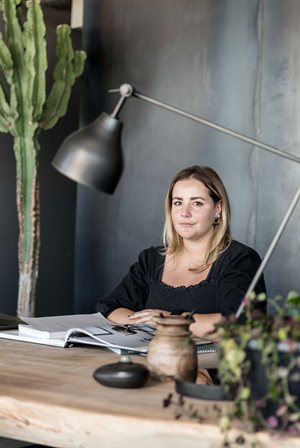The look and feel of a work-from-home (WFH) space has a profound and very direct effect on well-being, says Anna Weylandt, lead designer at Weylandtstudio. But there doesn't have to be a trade-off between wellness and productivity. Changing a few interior features could be the key to thriving both professionally and personally while adapting to the new WFH reality.

Anna Weylandt, lead designer at Weylandtstudio
As Weylandt explains, “Numerous studies have proven the correlation between general wellbeing and the spaces you choose to spend your time in. Colour, shape, texture – all these elements have a material effect on your psychological state and by extension, your physical health. At the moment, we’re spending a great deal of time helping our clients to design their WFH spaces in a way that makes a positive impact on their happiness and health.”
A number of psychologists turn to behavioural science for clues on how the interior design of our most frequented spaces affects our wellbeing. For example, a 2017 study led by Maryam Banaei at Iran University of Science and Technology found that curved forms like arches, wall curvatures and dome-shaped lighting are more emotionally stimulating and were rated as being more pleasurable. This same finding has been echoed by other researchers who found that curved spaces have an effect on the brain’s anterior cingulate cortex, which deals with emotional learning and motivation.
Weylandt elaborates: “The team at Weylandtstudio has consulted with a number of clients who needed to improve the way their spaces made them feel while working from home. In some instances, we’ve recommended a more considered approach to design, aimed at removing clutter to not only free up physical space but, by extension, headspace for clearer thinking. In other instances, we’ve leaned on the Danish principle of ‘hygge’ and advised clients to incorporate plush furniture and accessories that engender a quality of cosiness and warmth. The key is to strike a balance between your mental needs and your physical boundaries.”
Tackling 'zoom fatigue'
The recently coined term “zoom fatigue” is used to describe the psychological consequences of spending excessive amounts of time on video chat platforms. Its emergence is directly related to the surge in remote working. Making small but significant changes to the way you structure and decorate your space could be one of the ways to alleviate this condition.
“There is no one-size-fits-all solution to creating a WFH home space that is conducive to mental wellness, but there are a few tips that have proven to be almost universally applicable. Adding a plant to your space, for example, is one way of introducing an oxygen source into your home office and adding natural beauty to your interior. I am also an advocate for bringing as much natural light into your home office space as possible – the effects can be surprisingly mood-enhancing. Very simply, good design shapes the way we live.”









































